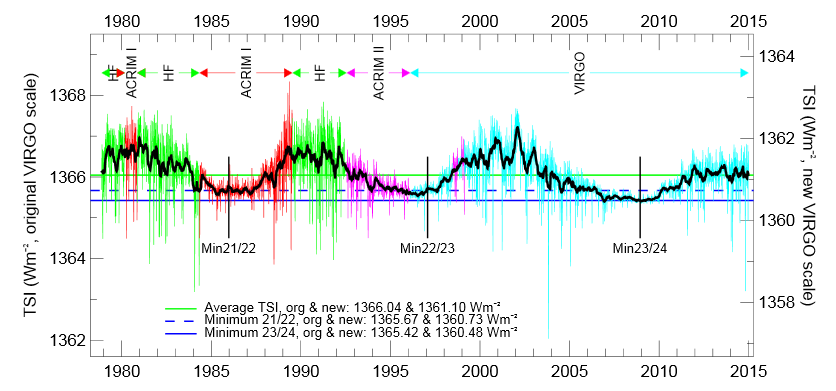The Solar Constant
The luminosity of the Sun is about 3.86 x 1026 watts. This is the total power radiated out into space by the Sun. Most of this radiation is in the visible and infrared part of the electromagnetic spectrum, with less than 1% emitted in the radio, UV and X-ray spectral bands. The Sun's energy is radiated uniformly in all directions.
Because the Sun is about 150 million kilometres from the Earth, and because the Earth is about 6300 km in radius, only 0.000000045% of this power is intercepted by our planet. This still amounts to a massive 1.75 x 1017 watts. For the purposes of solar energy capture, we normally talk about the amount of power in sunlight passing through a single square metre face-on to the Sun, at the Earth's distance from the Sun. The power of the Sun at the Earth, per square metre is called the solar constant and is approximately 1370 watts per square metre (W/m2).
The solar constant actually varies by +/-3% because of the Earth's slightly elliptical orbit around the Sun. The Sun-Earth distance is smaller when the Earth is at perihelion (first week in January) and larger when the Earth is at aphelion (first week in July). Some people, when talking about the solar constant, correct for this distance variation, and refer to the solar constant as the power per unit area received at the average Earth-Sun distance of one Astronomical Unit (AU) which is 149.59787066 million kilometres.
There is also another small variation in the solar constant which is due to a variation in the total luminosity of the Sun itself. This variation has been measured by radiometers aboard several satellites since the late 1970's. Figure 1 is a composite graph produced by the World Radiation Centre in Switzerland and shows that our Sun is actually a (slightly) variable star.

Figure 1. Composite daily values of the Sun's Total Solar Irradiance (TSI) from radiometers on different space platforms since November 1978: HF on Nimbus7, ACRIM 1 on SMM, ERBE on ERBS, ACRIM II on UARS, VIRGO on SOHO, and ACRIM III on ACRIM_Sat. The values of the average and the minima values are also given in the original VIRGO and new absolute VIRGO scales.
The variation in the solar constant has been about 0.1% over a period of about 30 years. Some researchers have tried to reconstruct this variation, by correlating it to sunspot numbers, back over the last 400 years, and have suggested that the Sun may have varied in its power output by up to one percent. It has also been suggested that this variation might explain some terrestrial temperature variations. It is interesting to note that the average G-type star (the class of star the Sun falls into) typically shows a much larger variation of about 4%.
Material prepared by John Kennewell and Andrew McDonald





